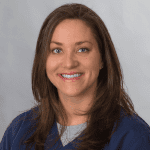An easy-to-use online tool to help guide individuals and families through the complexities of TSC across their lifespan, proactively manage their care and live their fullest lives.
Recently, I had the opportunity to sit down and talk with Ashley Pounders, Director of Medical Affairs for the TSC Alliance, about the value of the TSC Navigator, how and why patients should have access to more tools like this, and how the TSC Alliance hopes to enhance this tool moving forward.

Tuberous Sclerosis Complex (TSC)
Before we dive into what the TSC Navigator is, let’s give a brief overview of what tuberous sclerosis complex (TSC) is. As explained above briefly, TSC is a rare genetic disorder that was first described back in the 1880s. People with TSC have either TSC1 or TSC2 gene mutations, which cause cells to divide excessively. As a result, TSC causes the formation of benign (non-cancerous) tumors throughout various organs, including the heart, eyes, kidneys, skin, lungs, and brain. Ashley explains:
TSC is variable. We often don’t know how it will manifest.
TSC symptoms often begin to appear in infancy and childhood, though in mild cases, some people will not receive a diagnosis until adulthood. Signs and symptoms include:
- Developmental delays
- Skin abnormalities (growths under/around nails, thickened skin, light patches)
- Facial lesions resembling acne
- Dental enamel pits
- Cardiac tumors and vascular abnormalities
- Behavioral difficulties including repetitive behaviors, hyperactivity, aggression, and social or emotional withdrawal
- Vision loss associated with retinal or optic nerve hamartomas
- Lung diseases such as MMPH and lymphangioleiomyomatosis
- Brain abnormalities
- Seizures
- Renal cysts or other kidney abnormalities
Currently, there is no cure. However, there are therapeutic options to assist with symptom management. To learn more about TSC and its manifestations, check out this helpful guide from the TSC Alliance.
TSC Navigator
Ashley Pounders has always been interested in the medical field. In addition to working in TSC clinics and managed care, Ashley is a practicing hematology and oncology nurse practitioner. Thus far, she has been working with the TSC Alliance for nearly a year and describes the organization as:
A nonprofit organization that really strives to improve the lives of those affected by TSC. The main takeaway, from my standpoint, is to improve access to care for individuals with this condition by providing resources and education to help navigate their journey. We offer community support, a natural history database, information on clinical trials—basically whatever we can to bridge the gap between the TSC community and clinicians. We have our hand in a little bit of everything.
For Ashley, part of the allure of the TSC Alliance is the genuine passion that President and CEO Kari Rosbeck has for supporting the TSC community. She explains that Kari’s vision is amazing and continues to take the TSC Alliance to the next level. Through the wealth of resources for those who are newly diagnosed and those who are later in their journey, the TSC Alliance:
Strives for excellence and leaves no stone unturned when it comes to improving care. It is very compelling to be part of that.
One of the ways the organization is currently working to improve care is through the TSC Navigator, a project that Ashley led and developed. While the TSC Navigator had been a vision prior to her coming on staff, her expertise, along with others in the organization, spurred the project along.
The Purpose
As many people within the rare disease community know, it can be difficult—if not completely daunting—to attempt to search for information on your condition. Typing your condition into Google brings up innumerable results. But how do you know what is accurate and what relates to you? How can you make sure you’re getting accurate information for where you are in your journey? And perhaps most importantly, how can you make sure that you’re deciphering all the information correctly?

Overwhelming information is not the only barrier to care. Others include difficulties with medication access, as Ashley explains:
We all align together knowing that some of these life-saving medications are expensive. How do you mitigate these issues with families who don’t have the means to pay for it? Is it fair to pay thousands every month just to get medication? How can we, as an organization, make that better for them? Our goal is to cure TSC but that is the long-term. That doesn’t help families today so that their child doesn’t go into status epilepticus. Working with specialty pharmaceutical companies and trying to develop different plans and interventions is where we focus.
Additionally, how can advanced practices and nurses empower families? Where can pharmacies step up? How can families work with insurance? Overcoming these barriers is crucial to improving the overall quality of life for families, and this is the mission of the TSC Navigator. Says Ashley:
Our goal is to give patients or caregivers tangible takeaways. We offer a broad topic and some action steps so that people can proactively empower themselves as an advocate, patient, or caregiver. This resource was molded by an advisory panel made of community members, sponsors, advanced practice leaders. Now we can say, if you need help, here is where to start.
Learn more about the TSC Navigator. We will also go deeper into TSC Navigator Categories, as well as the future of the TSC Navigator, in Part 2.


